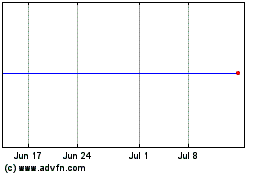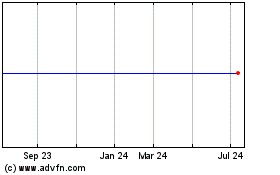AstraZeneca Gives Rejected Drugs a Second Life
March 13 2017 - 7:29AM
Dow Jones News
By Denise Roland
CAMBRIDGE, England -- AstraZeneca PLC executive Kumar Srinivasan
has an unusual job description: He is in charge of rejected
drugs.
Safe and effective drugs are sometimes shelved because they
don't work in a disease area that is of interest to the company in
question. Mr. Srinivasan's nine-person team, dubbed the Emerging
Innovations Unit, is in charge of around 20 drugs that AstraZeneca
has shelved, as well as about 45 molecules that never made it into
human testing.
Drugs developed with one disease in mind can have potential in
seemingly unrelated areas. Among the unit's projects is a
collaboration with scientists at Yale University School of Medicine
to investigate whether a drug that didn't make the cut as a cancer
medicine inside AstraZeneca could instead work in Alzheimer's
disease.
AstraZeneca is aiming to build credibility with academic
scientists as part of a broader move to drastically improve its
research-and-development output, which until just a few years ago
was among the industry's worst. It hopes that making its unwanted
molecules readily available to university researchers will give it
an edge over its rivals, most of which are reluctant to dedicate
resources to rejected drugs.
No other large companies are handing out their unwanted drugs
with the same enthusiasm as AstraZeneca -- but some are warming up
to the idea. In 2015, Novartis AG licensed three shelved drugs to a
U.K. startup called Mereo BioPharma Group PLC that is now
developing them in disease areas that don't fit with the Swiss
company's own priorities. As part of the deal, Novartis took an
equity stake in Mereo and will receive royalties from the eventual
sales of any of the drugs.
AstraZeneca's approach is part of a strategic shift its bosses
orchestrated about five years ago in the face of a drug pipeline
ill-equipped to offset the decline in revenue as its top-selling
drugs lost patent protection.
Mene Pangalos, head of innovative medicines, shifted to
rewarding scientists based on how many of their drug candidates
succeeded in later-stage testing, rather than the sheer volume of
candidates they produced. He also looked for ways the company could
support outside scientists, believing that would help AstraZeneca's
long-term research productivity.
Chief Executive Pascal Soriot accelerated Dr. Pangalos's work
when he arrived in 2012. He slashed the number of research jobs and
uprooted the company's historic research operations in Cheshire,
England, to the university town of Cambridge.
Like many other pharmaceutical companies, Astra is also looking
for new ideas from academic scientists to bolster its pipeline in
the long run. Dr. Pangalos hopes that sharing shelved molecules
with university scientists through the Emerging Innovations Unit
will put AstraZeneca at a competitive advantage to its peers when
those same scientists are looking for a company to share a new
breakthrough with.
Dr. Pangalos said Astra's research output has risen dramatically
thanks to the new strategy, which has also involved plowing more
investment into R&D and acquiring small biotechs to help fill
the pipeline. AstraZeneca's $5.6 billion core R&D budget in
2016 was 33% higher than the $4.2 billion it spent in 2010.
Between 2005 and 2010, just 2% of candidates that AstraZeneca
entered into human testing became successful drugs, Dr. Pangalos
said. In the subsequent five years, that figure jumped to around
15%.
AstraZeneca's late-stage pipeline has grown as well. Currently,
it is running more than 20 advanced clinical trials on 12 novel
drugs, compared with just nine such trials at the end of 2010.
For investors, the proof of AstraZeneca's turnaround will come
later this year, when it announces the results of a closely watched
clinical trial in previously untreated lung-cancer patients. If
successful, the so-called cancer immunotherapy approach could
generate as much as $3.5 billion in annual revenue for AstraZeneca,
according to UBS analyst forecasts.
Dr. Srinivasan said AstraZeneca spends tens of millions of
dollars a year on his unit, an investment he called "significant,
but not substantial."
The Emerging Innovations Unit, based in both Cambridge, England,
and Boston, has also become a small source of revenue for
AstraZeneca.
About a year ago, it licensed a shelved anti-inflammatory drug
to a Boston-based biotech founded by former AstraZeneca employee
Michael Davidson. That company, Corvidia Therapeutics, will test
the drug in cardiovascular disease. Two members of the Emerging
Innovations Unit followed Dr. Davidson to Corvidia. Astra took a
19% stake in the company and is entitled to future milestone
payments and royalties.
Around the same time, the unit sold the rights for a
discontinued schizophrenia drug candidate to Ann Arbor, Mich.-based
biotech Millendo Therapeutics Inc. That drug was shelved in 2008
because of some hormonal side effects, which later research
suggested could be useful in treating polycystic ovary syndrome, an
endocrine disorder.
AstraZeneca, Corvidia and Millendo haven't disclosed the
financial details of those deals, but Dr. Pangalos said the
proceeds from the transactions meant the unit was roughly
cost-neutral for the company.
Write to Denise Roland at Denise.Roland@wsj.com
(END) Dow Jones Newswires
March 13, 2017 07:14 ET (11:14 GMT)
Copyright (c) 2017 Dow Jones & Company, Inc.
AstraZeneca (NYSE:AZN)
Historical Stock Chart
From Mar 2024 to Apr 2024

AstraZeneca (NYSE:AZN)
Historical Stock Chart
From Apr 2023 to Apr 2024
